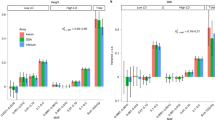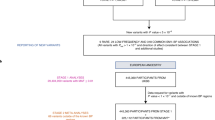Abstract
Sequence variation in human genes is largely confined to single-nucleotide polymorphisms (SNPs) and is valuable in tests of association with common diseases and pharmacogenetic traits. We performed a systematic and comprehensive survey of molecular variation to assess the nature, pattern and frequency of SNPs in 75 candidate human genes for blood-pressure homeostasis and hypertension. We assayed 28 Mb (190 kb in 148 alleles) of genomic sequence, comprising the 5´ and 3´ untranslated regions (UTRs), introns and coding sequence of these genes, for sequence differences in individuals of African and Northern European descent using high-density variant detection arrays (VDAs). We identified 874 candidate human SNPs, of which 22% were confirmed by DNA sequencing to reveal a discordancy rate of 21% for VDA detection. The SNPs detected have an average minor allele frequency of 11%, and 387 are within the coding sequence (cSNPs). Of all cSNPs, 54% lead to a predicted change in the protein sequence, implying a high level of human protein diversity. These protein-altering SNPs are 38% of the total number of such SNPs expected, are more likely to be population-specific and are rarer in the human population, directly demonstrating the effects of natural selection on human genes. Overall, the degree of nucleotide polymorphism across these human genes, and orthologous great ape sequences, is highly variable and is correlated with the effects of functional conservation on gene sequences.
This is a preview of subscription content, access via your institution
Access options
Subscribe to this journal
Receive 12 print issues and online access
$209.00 per year
only $17.42 per issue
Buy this article
- Purchase on Springer Link
- Instant access to full article PDF
Prices may be subject to local taxes which are calculated during checkout



Similar content being viewed by others
References
Jeffreys, A.J. DNA sequence variants in the G γ-, A γ-, δ- and β-globin genes of man. Cell 18, 1– 10 (1979).
Chakravarti, A. et al. Nonuniform recombination within the human β-globin gene cluster. Am. J. Hum. Genet. 36, 1239– 1258 (1984).
Chakravarti, A., Phillips, J.A. 3d, Mellits, K.H., Buetow, K.H. & Seeburg, P.H. Patterns of polymorphism and linkage disequilibrium suggest independent origins of the human growth hormone gene cluster. Proc. Natl Acad. Sci. USA 81, 6085 –6089 (1984).
Jorde, L. et al. Linkage disequilibrium predicts physical distance in the adenomatous polyposis coli region. Am. J. Hum. Genet. 54, 884–898 (1994).
Li, W.H. & Sadler, L.A. Low nucleotide diversity in man. Genetics 129, 513–523 (1991).
Nickerson, D.A. et al. DNA sequence diversity in a 9.7-kb region of the human lipoprotein lipase gene. Nature Genet. 19, 233– 240 (1998).
Harding, R.M. et al. Archaic African and Asian lineages in the genetic ancestry of modern humans. Am. J. Hum. Genet. 60, 772–789 (1997).
Chakravarti, A. Population genetics—making sense out of sequence. Nature Genet. 21, 56–60 ( 1999).
Lipshutz, R.J., Fodor, S.P., Gingeras, T.R. & Lockhart, D.J. High density synthetic oligonucleotide arrays. Nature Genet. 21, 20–24 (1999).
Wang D.G. et al. Large-scale identification, mapping, and genotyping of single-nucleotide polymorphisms in the human genome. Science 280, 1077–1082 (1998).
Chee, M. et al. Accessing genetic information with high-density DNA arrays. Science 274, 610–614 (1996).
Cargill, M. et al. Characterization of single-nucleotide polymorphisms in coding regions of human genes. Nature Genet. 22, 231–238 (1999).
Chakravarti, A. It's raining SNPs, hallelujah? Nature Genet. 19, 216–217 (1998).
Lander, E.S. The new genomics: global views of biology. Science 274, 536–539 (1996).
Kruglyak, L. The use of a genetic map of biallelic markers in linkage studies. Nature Genet. 17, 21–24 (1997).
Collins, F.S., Guyer, M.S. & Chakravarti, A. Variations on a theme: cataloging human DNA sequence variation. Science 278, 1580– 1581 (1997).
Risch, N. & Merikangas, K. The future of genetic studies of complex human diseases. Science 273, 1516–1517 (1996).
Housman, D. & Ledley, F.D. Why pharmacogenomics? Why now? Nature Biotechnol. 16, 492– 493 (1998).
Ward, R. in Hypertension: Pathophysiology, Diagnosis, and Management (eds Laragh, J.H. & Brenner, B.M.) 81–100 (Raven Press, New York, 1990).
Kurtz, T.W. & Spence, M.A. Genetics of essential hypertension. Am. J. Med. 94, 77–84 (1993).
Kaplan, N.M. Clinical Hypertension (Williams and Wilkins, Baltimore, 1994).
Jeunemaitre, X. et al. Molecular basis of human hypertension: role of angiotensinogen. Cell 71, 169–180 (1992).
Smithies, O. & Maeda, N. Gene targeting approaches to complex genetic diseases: atherosclerosis and essential hypertension. Proc. Natl Acad. Sci. USA 92, 5266– 5272 (1995).
Mockrin, S.C. Molecular Genetics and Gene Therapy of Cardiovascular Diseases (Marcel Dekker, New York, 1996).
Lifton, R.P. Molecular genetics of human blood pressure variation. Science 272, 676–680 (1996).
The History and Geography of Human Genes (eds Cavalli-Sforza, L.L., Menozzi, P. & Piazza, A.) (Princeton University Press, Princeton, 1994).
Bird, A.P. CpG-rich islands and the function of DNA methylation. Nature 321, 209–213 (1986).
Nei, M. Molecular Evolutionary Genetics (Columbia University Press, New York, 1987).
Li, W.H. Molecular Evolution (Sinauer Associates, Sunderland, 1997).
Charlesworth, B., Moran, M. & Charlesworth, D. The effect of deleterious mutations on neutral molecular variation. Genetics 134, 1289– 1303 (1993).
Nachman, M.W., Bauer, V.L., Crowell, S.L. & Aquadro, C.F. DNA variability and recombination rates at X-linked loci in humans. Genetics 150, 1133–1141 (1998).
Collins, F.S., Brooks, L.D. & Chakravarti, A. A DNA polymorphism discovery resource for research on human genetic variation. Genome Res. 8, 1229–1231 (1998).
Hacia, J.G. et al. Evolutionary sequence comparisons using high-density oligonucleotide arrays. Nature Genet. 18, 155– 158 (1998).
Venter, J.C. et al. Shotgun sequencing of the human genome. Science 280, 1540–1542 ( 1998).
Harpending, H.C. et al. Genetic traces of ancient demography. Proc. Natl Acad. Sci. USA 95, 1961–1967 (1998).
Eyre-Walker, A. & Keightley, P.D. High genomic deleterious mutation rates in hominids. Nature 397, 344–347 (1999).
Wolfsberg, T.G. & Landsman, D. A comparison of expressed sequence tags (ESTs) to human genomic sequences. Nucleic Acids Res. 26, 1626–1632 (1997).
Gerhold, D. & Caskey C.T. It's the genes! EST access to human genome content. Bioessays 18, 973– 981 (1996).
Collins, F.S. et al. New goals for the U.S. Human Genome Project: 1998–2003. Science 282, 682–689 (1998).
Harris, H. Enzyme polymorphisms in man. Proc. R. Soc. Lond. B. Biol. Sci. 164, 298–310 ( 1966).
Harris, H. & Hopkinson, D.A. Average heterozygosity per locus in man: an estimate based on the incidence of enzyme polymorphisms. Ann. Hum. Genet. 36, 9–20 (1972).
King, M.C. & Wilson, A.C. Evolution at two levels in humans and chimpanzees. Science 188, 107– 116 (1975).
Angrist, M. et al. Human GFRA1: cloning, mapping, genomic structure, and evaluation as a candidate gene for Hirschsprung disease susceptibility. Genomics 48, 354–362 ( 1998).
Gordon, D., Abajian, C. & Green, P. Consed: a graphical tool for sequence finishing. Genome Res. 8, 195 (1998).
Acknowledgements
We acknowledge the assistance of N. Bringht-Twumasi and R. Keefer for technical assistance in sample preparation, PCR analyses and sequencing; M. Mittmann and E. Hubbell for chip design; A. Berno for chip data analyses; N. Patil and C. Marjoribanks for cDNA samples; M. Zwick, H. Willard, C. Langley, E. Eichler and anonymous reviewers for comments on the manuscript; and M. Chee for his efforts at the initiation of this gene screening project. This study was supported by research funds from Case Western Reserve University, University Hospitals of Cleveland, National Heart, Lung & Blood Institute (U10 HL54466) and National Human Genome Research Institute (RO1 HG01847) to A.C. This study is a component of the GenNet network of the NHLBI Family Blood Pressure Program.
Author information
Authors and Affiliations
Corresponding author
Rights and permissions
About this article
Cite this article
Halushka, M., Fan, JB., Bentley, K. et al. Patterns of single-nucleotide polymorphisms in candidate genes for blood-pressure homeostasis. Nat Genet 22, 239–247 (1999). https://doi.org/10.1038/10297
Received:
Accepted:
Issue Date:
DOI: https://doi.org/10.1038/10297
This article is cited by
-
PLEACH: a new heuristic algorithm for pure parsimony haplotyping problem
The Journal of Supercomputing (2023)
-
Association between serotonin 2A receptor (HTR2A) genetic variations and risk of hypertension in a community-based cohort study
BMC Medical Genetics (2020)
-
Prospective avenues for human population genomics and disease mapping in southern Africa
Molecular Genetics and Genomics (2020)
-
Integrated genome sizing (IGS) approach for the parallelization of whole genome analysis
BMC Bioinformatics (2018)
-
Better ILP models for haplotype assembly
BMC Bioinformatics (2018)



